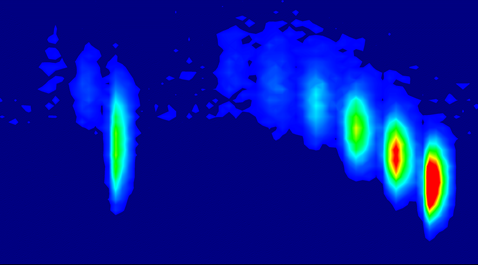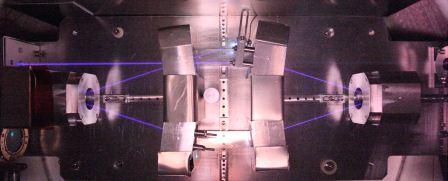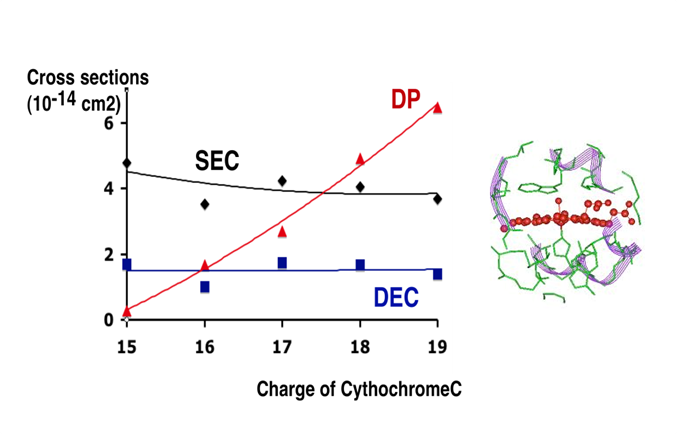Multicharged Ions Team (Ions Multichargés :IONS)
Excitation and relaxation dynamics of molecular ions in the gas phase
Our team studies the excitation and relaxation, in the gas phase, of small molecular ions of biological or astrophysical interest up to nanometer scale systems such as fullerenes or PAH (Polycyclic Aromatic Hydrocarbon) and recently to proteins.
In our experiments, the single or multi-ionization and/or the excitation of the molecules are induced by collisions with low energy ions (<20keV/charge) or by photon absorption with laser excitation.
Using a multiscale approch on both the size of the studied systems and the time (from ns up to second) of the involved processes, our goals are to study and understand the various relaxation modes (ionization, fragmentation, radiative emission) of the molecule as a function of the internal energy .
The studied dissociation mecanisms present interests for multidisciplinary fields.
As an example, the adenine molecule, a building block of DNA is important for exobiology as the formation of this molecule of life still rises unresolved questions about the origin of life on Earth.
PAH laboratory studies are also important from the astrophysics point of view due to the abundance of these molecules in the interstellar medium and understanding their formation in such extreme medium is a challenging task.
Highlights
 |
|
Molecular fragmentation under energy controlUsing the CIDEC method the internal energy of the molecular ion is measured for each fragmentation channel C60 (Phys. Rev. Lett. 2007, Phys.Rev. A 2009) Adenine (J.Chem.Phys. 2011) W(CO)6 (J.Chem.Phys. 2011) |
 |
Relaxation of molecule over a large time scaleExperiments using a compact electrostatic storage ring, the MiniRing (ANR 2010–042601 "ANNEAU"; ITSLEIF) Fast radiative cooling of anthracene cation was observed |
|
 |
Deprotonation (DP) processes observed in collisions between Xe8+ and multiply protonated cytochrome-CExperiments in collaboration with T. Schlathölter (KVI, The Netherland) and ILM Team SpectroBio of P. Dugourd. Supported by the COST Action MP1002 Nano-IBCT (Nanoscale insights into Ion Beam Cancer Therapy) |
2015: PhD thesis of MingChao Ji and Céline Ortéga
Research activities
CIDEC (collision induced dissociation under energy control)
An original method to measure the excitation energy of a complexe system (C60,70, DNA bases, W(CO)6, PAH)
Cooling of PAH using the MiniRing
Evolution of the internal energy of stored PAH cations (anthracene,naphthalene, pyrene, coronne) is probed using laser induced dissociation
Molecule, Biomolecule, PAH fragmentation induced by collision with multicharged ions: multielectron capture and fragmentation processes
Collisionnal (electron capture) and post-collisionnal (fragmentation) processes are studied in collisions between multicharged ions and neutral molecules or clusters
Electron capture and fragmentation of molecules of biological interest (adenine, deoxyribose).
Deprotonation processes were observed in collisions between Xe8+ and multiply protonated cytochrome-C (Phys.Rev. A 2014)
Negative ion production
Production of negative ions are studied in collisions between multicharged ions and neutral molecules or clusters
Experimental setups
ECR ion sources
Multicoincidence collision experiment: recoil ions (Time-Of-Flight mass spectrometry) and ejected electron (number mesured with silicon detector PIPS) are detected in coïncidence with the energy and charge of the scattered projectile ions
Compact electrostatic storage ring: MiniRing
Double focusing mass spectrometer Finnigan MAT95XP
Nanosecond laser EKSPLA NT242: 532nm, 355nm; OPO 210nm - 2.6µm; 1kHz repetition rate

















